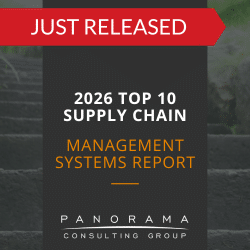You’re ready to streamline your operations and make your workflows more efficient. You also want to improve employee performance and make your customers happy. Will enterprise resource planning (ERP) software help you meet those objectives, or is product lifecycle management (PLM) a better fit?
Today, we’re talking about PLM vs ERP to help you make a more informed decision.
What is ERP?
ERP software integrates your organization’s core business processes into a single, comprehensive platform accessible by all employees.
This solution helps you organize, automate and manage your day-to-day functions, such as accounting, procurement, project management and supply chain management. Optimizing and simplifying these processes results in more accurate reporting, easier communication and improved data insights.
In terms of product management, ERP systems can handle the processes behind taking a product to market. These systems enable you to manage logistics, implement warehouse best practices and optimize inventory management.
The 2025 ERP Report
72.6% of respondents said they've already deployed AI at their organizations. Learn about AI adoption and other ERP trends by downloading our latest report.
What is PLM?
PLM software is specifically designed to help companies manage the full lifecycle of the products they produce. It includes individual components that plan, organize and track the following stages:
- Design
- Engineering
- Manufacturing
- Sales and marketing
- Customer service
There are a variety of processes, personnel and data inputs required to keep these activities running smoothly, and PLM coordinates and organizes them all.
It also serves as a valuable system of record for all the intellectual documentation and communication associated with your processes. By integrating and aligning these resources, PLM platforms help companies mitigate risks, facilitate team member collaboration, quicken time to market and lower product costs.
PLM vs ERP: What are the Major Differences?
If you’ve been in business for a while, you’ve likely already heard of ERP software. You may even be planning an upcoming ERP implementation.
That said, do you need both ERP and PLM to achieve enterprise-wide optimization, or can you just invest in one system? The basic differences between ERP and PLM originate in their product-related functions:
Product-related ERP Functions
In short, ERP is focused on the direct, execution side of product development. This software helps employees manage and access data related to making a product and getting it to market. These tasks typically fall on those involved in manufacturing operations and focus on securing product resources and tracking financials.
Product-related ERP functions include:
- Vendor and material selection
- Inventory management
- Expense monitoring
- Revenue prediction
- Compliance
Product-related PLM Functions
On the other hand, PLM is more concerned with the creative and collaborative planning that must take place throughout this same lifecycle. PLM users tend to be developers and engineers who need to collaborate to fine-tune a new product.
PLM functions usually include:
- Managing product designs
- Developing the bill of materials (BOM)
- Researching product-related services
- Facilitating red-line collaborations
- Sampling and fitting
- Assortment planning
- Seeking approvals and signoffs
- Managing change requests
Integrating ERP and PLM Software
In many cases, ERP and PLM software can complement one another. Integrating these systems helps companies achieve full product development control.
While many ERP systems have PLM modules, some organizations need more specialized PLM functionality. To meet this need, they choose to implement a separate PLM system and integrate it with their ERP system.
The Benefits of Integration
PLM software provides a single point of reference to inform the ERP database. With the inputs provided by PLM, ERP is better able to track and manage the operational side of product development.
While PLM software allows your teams to take care of all the steps required to plan, define and design the look and feel of a product, that’s only part of the puzzle. With PLM-ERP integration, users can then use those files and bills of material to order, build and ship the products to customers.
Overcoming Integration Challenges
One of the main challenges that some companies face when integrating PLM functionality into their ERP system is pushback over learning a new platform. Your teams may be familiar with ERP, but adding PLM components could alter their workflows.
This shift can breed change resistance if it isn’t handled with care. By prioritizing organizational change management, communicating updates and training employees, managers can mitigate this risk and ensure against operational downtime.
Another potential roadblock is the onslaught of options that businesses will face as they select their PLM vendor. Both the ERP selection and PLM selection phase can be a challenge, especially as vendors continue to add features to their offerings.
We recommend minimizing your excitement about “bells and whistles” and instead choosing a solution that’s aligned with your long-term digital strategy.
From Concept to Customer: Optimizing Product Development with ERP and PLM
In the PLM vs ERP debate, there isn’t one winner. That’s because both of these tools are useful in their own right.
With PLM software, employees can brainstorm, design and plan the key details of their next launch. Then, they can use ERP to turn those visions into reality, allocating resources, funds and personnel to bring a product to life.
Our team of ERP consultants can help you understand if implementing PLM functionality is a smart move for your business. If so, we’ll help you select a modern solution that enables greater transparency and improved product quality. Contact us below to learn more and request a free consultation.














